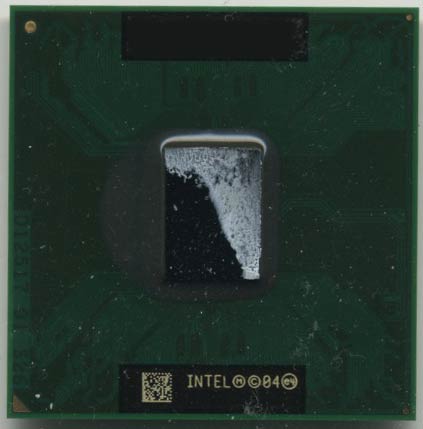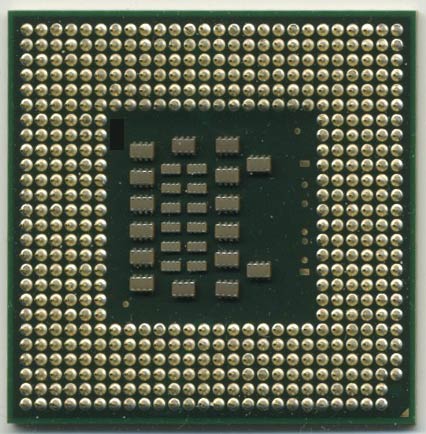Intel Yonah Performance Preview - Part I: The Exclusive First Look at Yonah
by Anand Lal Shimpi on November 30, 2005 2:50 AM EST- Posted in
- CPUs
Intel, oh Intel, how uninteresting your processors have been to us for so long now. Where have the days of the Northwood gone? Prescott brought us a minor bump in clock speed, minor increases in performance, and more importantly - major increases in power bills. But if any company can go down the wrong path for five years and still come out on top, it’s Intel. So starting next year, we’ll start seeing a new Intel. A more power conscious Intel and to kick it all off will be Intel’s first Earth-friendly dual core processor: Yonah.
As the successor to the current Pentium M (Dothan) and the predecessor to next year’s Conroe, Merom and Woodcrest cores, Yonah is a very important chip. As a mobile processor Yonah will bring dual core to thin and light notebooks, basically anywhere you’d find a Pentium M, you’ll now be able to find two Pentium Ms. The implications for mobile performance are huge, as multitasking on notebooks has rarely been all that great of an experience. At the same time, Yonah is so much more than just a dual core mobile processor - it’s a predictor of the performance of Intel’s next-generation desktop micro-architecture. Sure, it won’t have all of the architectural bells and whistles that we’ll see when Conroe debuts at the end of next year, but it’ll have many and that makes it a reference point.
The problem with the Pentium M architecture has been that although it’s traditionally done well at office tasks and obviously in the power consumption department, it has lagged behind the Pentium 4 and Athlon 64 when it comes to FP intensive applications such as video encoding, and to a lesser degree, 3D gaming. With Yonah, Intel has promised to address those performance issues, and even more so with their next-generation micro-architecture later next year. But we tend to want to see things for ourselves, and Yonah will at least give us an indication of how things have improved since Dothan, and whether or not Intel is on the right track to replacing the Pentium 4.
By now we’ve hopefully stressed the importance of Yonah, and there’s just one more detail to mention - we have one.
The Platform - Yet Another Socket
While the launch of Yonah still won’t be until January of next year, we’ve had a chip for the past month, unfortunately, we haven’t had a motherboard to stick it in. We finally got one two days ago, which is why you’re seeing this article now, instead of more pictures of our Yonah posing alongside the Xbox 360. The problem is that Intel seems to have changed sockets once more, meaning that Yonah is not backwards compatible with the original Pentium M socket.

If you’ll remember back to the introduction of the Pentium M, Intel introduced a brand new socket for the processor: Socket-479. Back then, the desktop Pentium 4 still used the pin-based Socket-478, so the different pin-out was a bit of a pain to deal with as we all wanted to be able to stick Pentium Ms in our Pentium 4 motherboards.

The Yonah socket is still a 479-pin interface, however the pin-out has been changed once more, and of course Yonah won’t even physically fit into any current Pentium M motherboards. Instead, you’ll need a brand new motherboard with a brand new chipset. So if you invested in any of the handful of desktop Pentium M motherboards that were released over the past year, you’re unfortunately out of luck.

Yonah (left) vs. Dothan (right) - Note the different pin-out
What’s this about a new chipset? Well, it’s not exactly a new chipset, rather it’s Intel’s mobile 945 chipset - the mobile version of the desktop chipset we’ve had for quite some time now. The platform we’re testing on in particular uses Intel’s 945G chipset, with integrated graphics, but of course we aren’t too interested in integrated graphics performance so we’ll be using the PCIe x16 slot on the board.
While we can’t tell you who makes the motherboard we’re testing with, the important thing to note is that it is a desktop motherboard made specifically for Yonah. It’s got a single PCIe x16 slot, meaning you don’t have to rely on integrated graphics, and all of the bells and whistles you’d expect from a desktop motherboard; this could very well be the heart of your next system.
We’ve been hearing that Pentium M based desktops will become a lot more common next year, and this motherboard is definitely an indication of that.










135 Comments
View All Comments
coldpower27 - Wednesday, November 30, 2005 - link
It doesn't seem that bad actually at 423US for 2.0GHZ Yonah at launch, it isn't double the 294US, that they are charging for Dothan 2.0GHZ parts now, the price isn't like the double we are seeing on Athlon 64x2.Furen - Wednesday, November 30, 2005 - link
Huh? I'm saying that the FX-60 will probably match the EE edition of Yonah, which (supposedly) will have a 50+ W TDP and will hardly be a "mid-range" mobile chip.coldpower27 - Wednesday, November 30, 2005 - link
These are the leaked pricing sheets from around the web on the launch pricing of Yonah.T2600/ Yonah 2.17GHZ/667/2MB 637US
T2500/ Yonah 2.00GHZ/667/2MB 423US
T2400/ Yonah 1.83GHZ/667/2MB 294US
T2300/ Yonah 1.67GHZ/667/2MB 241US
T means somewhere in 25W-49W TDP
Yonah Extreme Edition would be interesting, either 2.5GHZ/2.66GHZ if on the same FSB speed.
Furen - Wednesday, November 30, 2005 - link
It would have been nice if you'd included Dothan's power consumption just to see whether or not the "Yonah will have a 49W TDP" claims have any validity. I dont suppose you guys are up to testing the current CPU's current draw directly, huh? :)coldpower27 - Wednesday, November 30, 2005 - link
Also you got to keep in mind Yonah will fall in the T category, of processors which is 25W-49W in TDP, with the way Intel measures it. The acutal TDP of Yonah was supposed to be 31W.Furen - Wednesday, November 30, 2005 - link
Yes, but when Intel announced that Yonah was going to fall into that category EVERYONE (most tech sites, heck, even Cnet) equated that to a higher TDP Yonah, which is why it would have been nice to have something to compare it against.bob661 - Wednesday, November 30, 2005 - link
Anandtech is NOT measuring TDP in these tests!!!!!! They ARE measuring what they call "Total Power Consumption". These are two TOTALLY different measurements. AT can only measure power consumed by the ENTIRE computer coming from the wall socket. They can't measure TDP in these tests. It's not the same. It's not the same. Jesus!Furen - Sunday, December 11, 2005 - link
I never said they could measure TDP. I asked if they were willing to measure the CPU's current draw directly, which is VERY doable, though it takes a bit more effort. If you remember that a month or so ago there were news articles published at, basically, all tech news sites claiming that Yonah would have a greater TDP than it was originally anticipated. Though TDP is not necessarily the typical power draw, a higher TDP (compared to another one that is defined the same way) can lead to a higher current draw.I said that it'd be nice if they could include dothan in order to have a CPU with which to do an apples to apples comparison. Try to keep your patronizing comments to yourself if you don't plan on at least reading what you're commenting on properly.
Calin - Friday, December 2, 2005 - link
Nobody can measure the TDP - TDP is the Total Designed Power - and refer mostly to the cooling capacity of the processor package. You will see several models of processors having the same TDP even if their power consumption is certainly different.The Sempron 2500, 2600, 2700 and I think 2800 have the same TDP - even if the 2500 is a 256kB L2 cache part and the 2600 and 2800 have just 128kB L2 cache.
TDP is NOT power consumption!
Calin - Friday, December 2, 2005 - link
Sorry. TDP is thermal design power